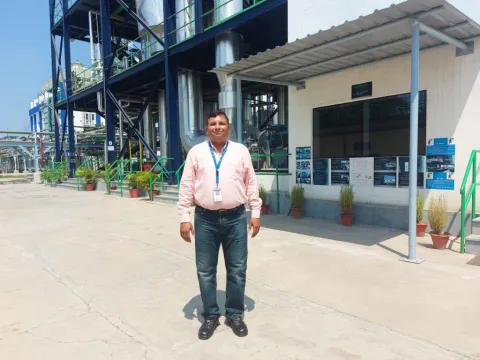Centrient's Toansa Manufacturing Site in India Leads the Way in Wastewater Management
Water is a vital resource for humanity, and it is becoming increasingly scarce in most parts of the world. According to the World Health Organization (WHO), over 2 billion people live in water-stressed countries. Population growth, climate change, antimicrobial resistance, and environmental pollution make the situation worse. While some critical contamination risks in drinking water arise from arsenic, fluoride or nitrate, emerging contaminants, including pharmaceuticals, pesticides, and microplastics generate public concern.
When manufacturing pharmaceuticals, environmental sustainability can no longer be viewed simply as an add-on to core business practices. At Centrient Pharmaceuticals, we believe safeguarding the environment is the only way forward for companies like ours. Our goal is not simply to meet the environmental demands and compliance standards of the different regions and communities where we operate. We aim to lead the way in environmental sustainability within the pharmaceutical supply chain by setting up strict standards for wastewater management for us and our suppliers.
Water stewardship at Centrient India
Clean water and sanitation are crucial to our sustainable manufacturing approach, as evidenced by Centrient India's site-based wastewater treatment plants, water recycling programmes, and projects supporting local communities with clean water. Despite the recent significant growth of our operations in Centrient´s site in Toansa, India, we take an integrated approach to wastewater treatment.
Yoginder Bhatia, Centrient's Waste Water Plant Manager in India, Bangladesh, and the Asia Pacific region says: “Having worked at the wastewater plant for the past 20 years, I feel immensely proud to be a part of such a committed team of professionals at Centrient. Pollution poses a great threat to the environment we will leave for the next generations. At Centrient, we take every step to ensure that the environment is protected from industrial pollution by treating all our waste responsibly and employing the latest technologies in wastewater management.”
Modernisation of our Wastewater Treatment Plant
We equipped Centrient's Toansa site with the most modern wastewater treatment technology and continue to invest in upgrading the facilities in line with new trends and regulatory requirements. In 2021, we added an anaerobic wastewater treatment option for specific streams. The anaerobic water treatment is a biological process that breaks down organic contaminants found in wastewater using microorganisms without oxygen, lowering the energy consumption rate.
In addition, we substituted our Multiple Effect Evaporator (MEE) with Mechanical Vapor Recompression (MVR), significantly increasing the amount of water recovery and reducing carbon footprint. The previous MEE unit used large volumes of steam for heating. However, because the condensate it generated contained high levels of pollutants, it was not suitable for recycling into steam boilers.
In contrast, the MVR technology uses electricity to recompress vapours generated from effluents. The condensate generated from the steam is recycled back to boilers, allowing 30,000m3 of water to be recycled at Toansa each year. Furthermore, minimising the site’s consumption of fossil fuels for steam generation has reduced its CO2 emissions by 4,000 metric tons and its SO2 emissions by 40 metric tons per annum, ensuring a cleaner environment and better air quality around the site. In the future, we plan to start generating power from the methane gas produced as a by-product.
Wastewater testing methodology
We take a structured approach to wastewater testing in all our manufacturing sites. In 2018-2019, Centrient collaborated with DSM Biologics in Delft, the Netherlands, to develop and validate an analytical method based on US EPA 1694 that can measure the concentration of residual antibiotics as per the PNEC values. The highly-sensitive testing method runs on an advanced instrument called HPLC/MS/MS. In May 2022, we were the first in the industry to publicly announce meeting the stringent PNEC discharge targets for our complete oral antibiotics product range and their supply chains. Many subject matter experts on antimicrobial resistance (AMR) from SPHS, the National Centre for Disease Control, the Centre for Science and Environment, as well as Dutch experts through the Netherlands Embassy in India and various other regulatory bodies visited the Toansa site over the past three years. These inspections showed that the concentration of chemicals in our wastewater is below the concentration level to affect the local ecosystem adversely.
Water recycling and waste management
At the Toansa site, we recycle treated wastewater for use in our cooling towers. In 2020 and 2021, we avoided extracting 86,313 kilolitres of water from the ground. The water saved through this direct conservation method is enough to meet the needs of 2,500 people for an entire year.
We are in complete control of our waste management at the Toansa site. Regarding solid waste management, we decontaminate the waste from packaging containing traces of intermediates and Active Pharmaceutical Ingredients (APIs) before sending them to approved recyclers or a controlled landfill. Most spent solvents are recovered on-site by distillation. As outlined in our ESG Vision 2021-2030, we pledge to minimise our environmental impact by repurposing 90%of our waste and zero landfill waste by 2030.
We, at Centrient, recognise the critical need for responsible wastewater management and work hard to have the most sustainably made essential medicines for patients worldwide while minimising our impact on the environment, water consumption and preventing antimicrobial resistance in the communities in which we operate.

